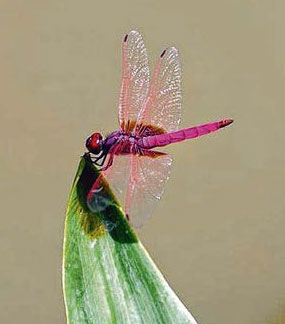The Straits Times (5 April 2018) - S’pore scientists develop nano coating that kills up to 99.9% of germs on surfaces
Singapore researchers have found a powerful new tool in the fight against bacteria, and their discovery took flight on the wings of dragonflies and cicadas.
A group of scientists here has found that the wings of these insects are covered with minuscule “nails” known as nanopillars, which instantaneously tear apart bacteria that come into contact with them.
Inspired by this, the team at the Institute of Bioengineering and Nanotechnology (IBN) has spent the past four years developing an anti-bacterial nano coating using zinc oxide, a compound known for its non-toxic and anti-bacterial properties.
Tests on ceramic, glass, titanium and zinc surfaces have shown that this coating effectively kills up to 99.9 per cent of germs on surfaces.
By completely destroying the bacteria upon contact, the coating prevents the formation of resistant bacteria.

Researchers at the Institute of Bioengineering and Nanotechnology are inspired by the wings of insects like the dragonfly, which are covered with minuscule “nails” known as nanopillars that instantly tear apart bacteria coming into contact with them.
PHOTO: MEI HWANG
It also guards against environmental pollution by physically tearing apart the bacteria, rather than killing them chemically.
“Our nano-coating is designed to disinfect surfaces in a novel yet practical way,” IBN group leader Zhang Yugen told The Straits Times.
This new material may mark a pivot point in the world’s fight against bacteria, which has been a long-drawn one with no clear solution.
According to the BC Centre for Disease Control in Vancouver, 80 per cent of common infections are due to the spread of bacteria by touch. While disinfectants can help to reduce bacteria, they have to be used regularly due to the quick multiplication of bacteria.
They also contain chemicals like triclosan which could be unsafe, and consistent use of disinfectants often leads to bacterial resistance and environmental contamination.
“There is an urgent need for a better way to disinfect surfaces,” said IBN executive director Jackie Ying. Knowing that the new surface-coating technology would be of interest to hospitals, Professor Ying has initiated a collaboration with Tan Tock Seng Hospital (TTSH) to test the commercial application of the new invention.
Dr Shawn Vasoo, a consultant at the Institute of Infectious Diseases and Epidemiology at TTSH, described this as a “natural partnership” to resolve a “pressing issue”.
TTSH will test the effectiveness of the technology against resistant clinical and environmental strains of micro-organisms.
There are also plans to test the material in a hospital setting if the laboratory trial is successful.
Of the new technology, Dr Vasoo said: “It is an attractive strategy as it avoids the use of anti-microbials on surfaces or other chemicals which may leach into the environment, and is potentially very scalable.” Together with TTSH, IBN has also successfully applied for a grant from the National Research Foundation.
With greater funding and the opportunity to test this material in a real-life setting, Dr Zhang looks forward to “one day creating bacteria-free surfaces throughout Singapore with this technology”. IBN also plans on conducting further studies to see if the nano-coating technology can be used for water purification and air filtration.